Canadian Bostons
By Jim White, Indianapolis, IN
Reprinted from "Crown Jewels of the Wire", February 2007, page 30
Preface
It might seem a bit of heresy for someone who had his/her collecting roots
from 1968 to 1978 firmly planted in Muncie, Indiana (one of the
"Homes" of Hemingray), as a student and staff member at Ball State
University. During that period I became hooked on the hobby and developed an
extensive Hemingray collection which was eventually sold in 1978. How I got
started again is another story for another time.
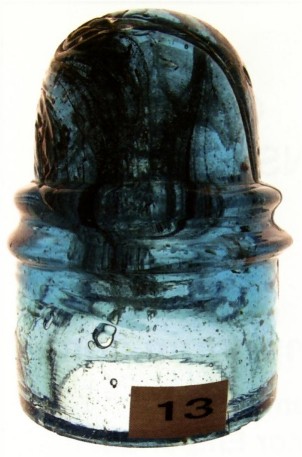
Upon my return to the hobby about three years ago, I focused on Canadian 102
ponies. At the 2005 Springfield, Ohio show my collection evolved to another
level, as many collections do, to include another "sub-collection",
that of CD 136.4 Canadian Bostons. During my initial years of collecting I
always had an attraction to the CD 136s (B&Os - below, left), so it was a
natural for me to be attracted to their Canadian made "cousin", the
136.4.
Sometimes, interests are launched by the purchase of one item. Such was the
case for me. Ray Klingensmith had a slaggy 136.4 that had my name on it (#13,
above). I thought about that purchase for the entire show and hoped that no one
would grab it up before I could make my decision. It certainly had caught the eye
of many collectors. Upon leaving the show, I made the purchase and never
regretted the decision.
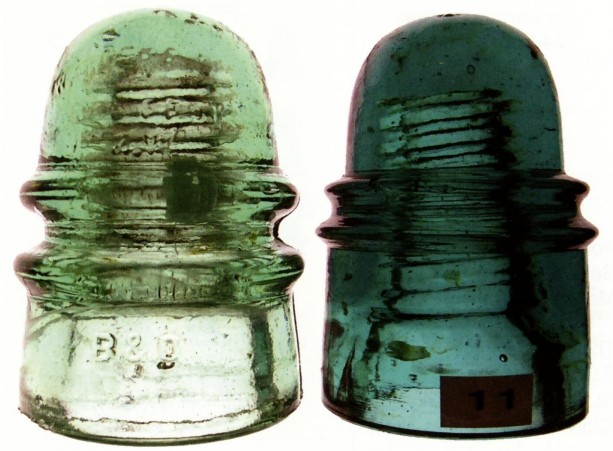
A fellow Canadian collector with limited funds at this year's show was trying
to make a similar decision. The only words of wisdom I could offer was,
"Imagine you are 200 - 300 miles down the road headed home, would you
regret not having purchased the item?"
The Display
In creating the display I knew I would be at a bit of a handicap as Canadian
Bostons have a long history but not much recorded information. So the direction
I took was to examine more closely and note the characteristics of the 136.4s in
my possession. In doing so, I have to admit to learning a lot more about these
insulators. I am not suggesting that any reader become a specialist, but I
certainly can say that there are some benefits in being able to study the fine
details and differences within a CD that might otherwise be overlooked.
Character
Other than the unique barrel shape, these glass artifacts are defined by
their very thick, crude glass. Quality control in their production appears not
to have been very high resulting in each piece being a one of a kind.
|
The "DOT"
I had always thought that all Canadian Bostons had the "Dot" on the
dome. Closer examination found this not to be true. Discussion with other
collectors speculates that the 'DOT" performed a function in helping keep
the mold from turning during production.
|
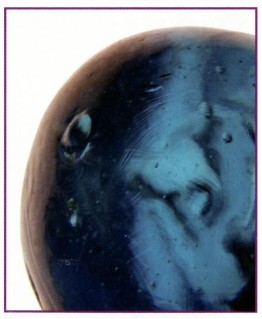 |
The Threads
Canadian Bostons have what I will call the "normal" or usual thread
pin hole, and they are also found with a segmented thread, very similar to the
American insulators made by Boston Bottle Works. The segmented thread is the
brainchild of Samuel Oakman and was intended to assist in the removal of the
mandrel or plunger from the finished product. The segmented threaded version is
a very desirable item. Editor's Note: Canadian made + Boston (segmented)
threads explains the nickname: Canadian Bostons.
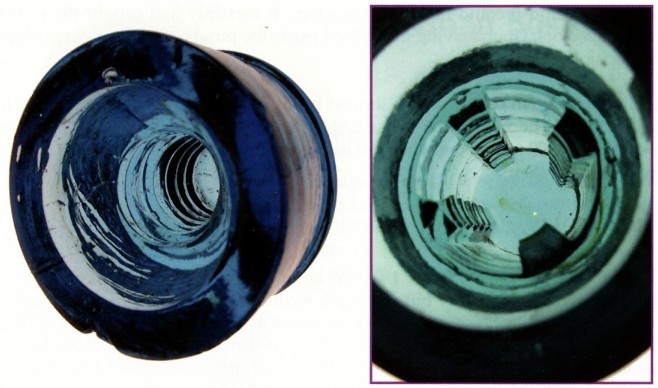
|
Above, Left - Normal threads; Above, right: example with segmented threads;
Right: side view of CD 136.4 with segmented threads.
During the Springfield show this year I purchased 5 Canadian Bostons. One had
an unusual thread condition which appears that the mandrel that is inserted into
the mold to form the threads had been pulled too early causing the threads to be
curved and pulled down toward the base. (Below left, close-up below right)
|
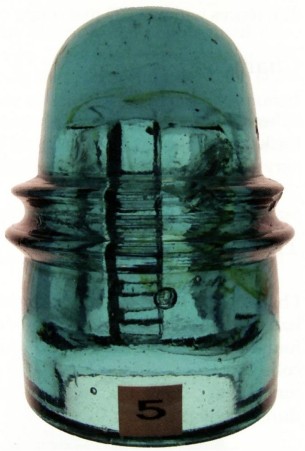 |
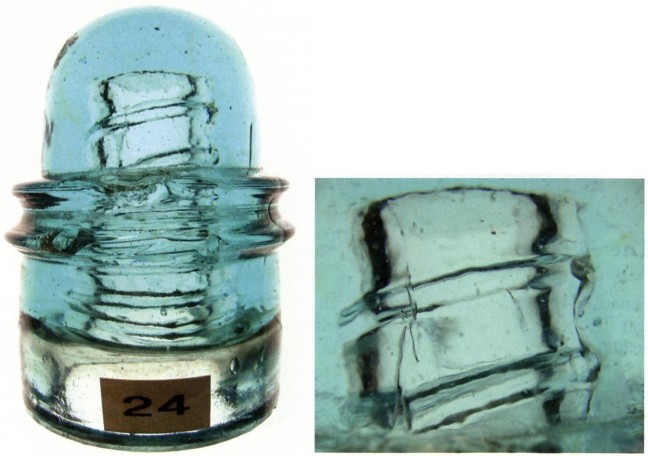
|
The Wire Groove
The typical wire groove is what I will term "rounded"; however,
there are examples that have a wire rim that protrudes outward more and also is
sharp in design. Discussion with other collectors has suggested the idea that
this could be a transition design. Certainly the sharper wire ridge is not seen
as often.
|
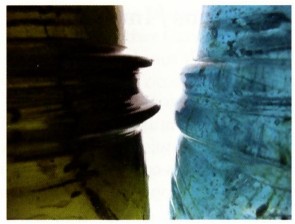 |
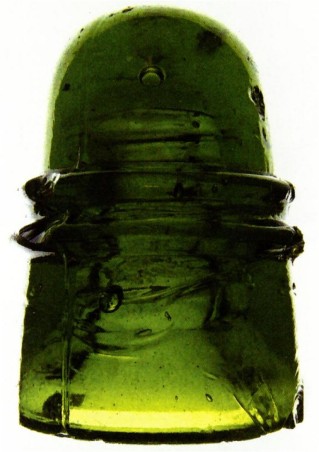 |
Colors
Color seems to be king in the hobby. A Canadian Boston collection does not
have to be relegated to aqua and blue. There is a nice range of color in this
CD, but with color comes considerable increased value. Colors include: Aqua,
blue aqua, dark green aqua, light aqua, green, emerald green, yellow green, lice
aqua, light blue, sky blue, sapphire blue, light green, turquoise blue, dark
green, dark teal green, dark yellow olive green. These are the list colors from
the McDougald's Price Guide. Who knows what other variations may exist?
|
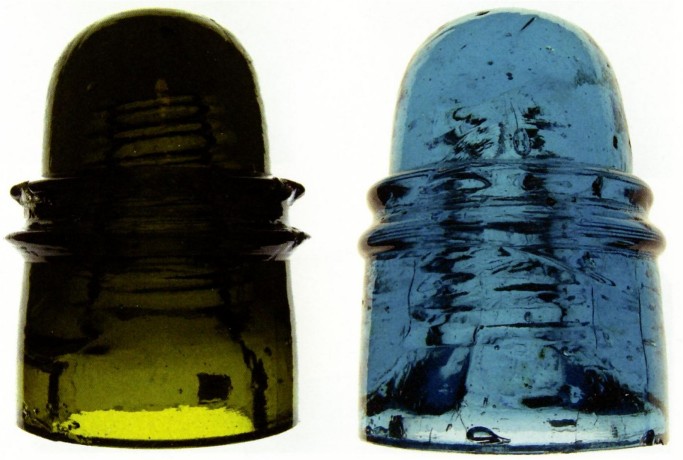
|
Inclusions / Imperfections
Canadian Bostons can have some very interesting inclusions of milk and amber.
These sometimes occur as small wisps or concentrations of milk, or as some
collectors commonly refer to them "tadpoles". Carbon inclusions are
also found in some samples.
|
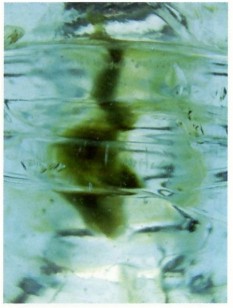 |
Damage
From my rather small sampling of 26 pieces, I observe that the main damage
one finds is (1) wire groove / wire rim chips and (2) hairline cracks, primarily
in the dome areas. Again, discussions with other collectors suggest that the
damage at the wire rims / grooves is likely a man induced damage from the
lineman not being too careful when changing out the line. I have many specimens
where the damage is at the wire groove area and yet the base is perfect or
nearly perfect.
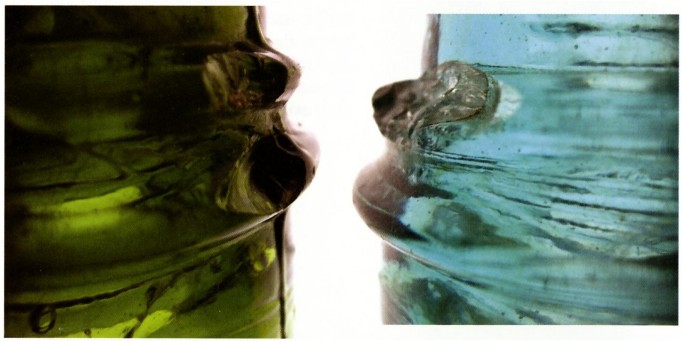
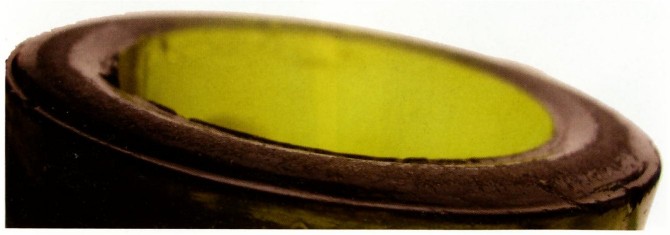
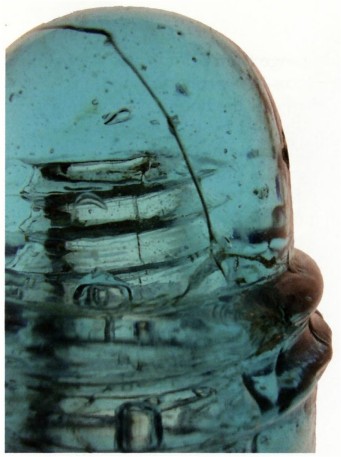
The hairline cracks abound. I have also noted this in other Canadian glass
like the 102s. Check out the teal blue 102s, it is a frequent occurrence to see
hairline cracks in the skirt. I frequently have wondered if this is a function
of glass quality and the adverse weather conditions? I have one piece where the
dome has cracks due to freeze and thaw of the pin and the pin being screwed too
tightly.
Weight
I thought it would be interesting to do a comparison of weight and height.
Here's a spreadsheet showing comparisons. From a scientific stand point, the
accuracy is affected on some pieces by the damage which has removed glass and,
therefore, weight.
|
No.
|
Weight
(lbs.)
|
Height
(inches)
|
Wire
Rim
|
Noted
Characteristic
|
Dome
Dot
|
|
|
|
|
|
|
|
|
1
|
1.77
|
4.0625
|
Rounded
|
Light Blue/ Milky Swirls
|
Yes
|
|
2
|
1.73
|
4.0000
|
Rounded
|
Sky
Blue
|
Yes
|
|
3
|
1.70
|
3.7500
|
Rounded
|
Sky Blue
|
Yes
|
|
4
|
1.70
|
3.9375
|
Rounded
|
Yellow Green
|
Yes
|
|
5
|
1.49
|
3.9375
|
Sharp
|
Aqua, 4 Segmented Threads
|
No
|
|
6
|
1.58
|
3.8750
|
Rounded
|
Light
Blue With Milk
|
Yes
|
|
7
|
1.62
|
3.9375
|
Sharp
|
Olive
|
No
|
|
8
|
1.49
|
3.7500
|
Rounded
|
Light Sky
Blue
|
Yes
|
|
9
|
1.53
|
3.7500
|
Rounded
|
Light Blue
|
Yes
|
|
10
|
1.61
|
3.7500
|
Rounded
|
Light Sky
Blue
|
Yes
|
|
11
|
1.63
|
4.0000
|
Sharp
|
Dark Aqua
|
Yes
|
|
12
|
1.62
|
3.9375
|
Sharp
|
Light Aqua /
Milk
|
No
|
|
13
|
1.42
|
3.7500
|
Rounded
|
Light Blue
|
Yes
|
|
14
|
1.67
|
4.0000
|
Sharp
|
Aqua
|
Yes
|
|
15
|
1.63
|
3.8750
|
Rounded
|
Milky Sky Blue
|
Yes
|
|
16
|
1.70
|
3.8125
|
Rounded
|
Aqua With Hint of
Green
|
Yes
|
|
17
|
1.63
|
3.7500
|
Rounded
|
Light Blue
|
No
|
|
18
|
1.52
|
3.8750
|
Rounded
|
Light Blue
|
No
|
|
19
|
1.76
|
3.8750
|
Rounded
|
Light Blue, Blob of Milk
|
Yes
|
|
20
|
1.65
|
3.7500
|
Rounded
|
Light Blue
|
Yes
|
|
21
|
1.62
|
3.8750
|
Rounded
|
Light Blue, Micro Bubbles
|
Yes
|
Average weight: 1.62 pounds
Value
This may sound pretty standard but values range from $75 to $7,500 depending
on condition and color. The most valuable pieces in my collection could probably
be picked out by someone with little knowledge of the hobby. The yellow olive
and olive green are most difficult to find, followed by the slaggy version (my
first purchase). I like to refer to value as being determined by the 3 -
"Cs": (1) color, (2) condition and (3) character. Character is often
the ironic event of the production of an insulator that is less than perfect by
typical glass standards. That may mean inclusions of foreign materials,
embossing and mold errors or changes, or deformities during production (e.g. -
under pours = not enough glass in the mold).
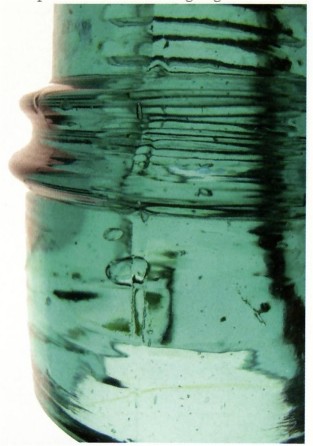
MLOD
Most collectors know this term to stand for "mold line over the
dome". This means a glass insulator formed in a two piece mold leaving a
distinct line from the base, over the dome and returning to the opposite base.
The MOLD means a vintage piece.
Background
Jim is a residential land developer in northern Indianapolis. He has a varied
collecting background including "collecting a family of 5 children".
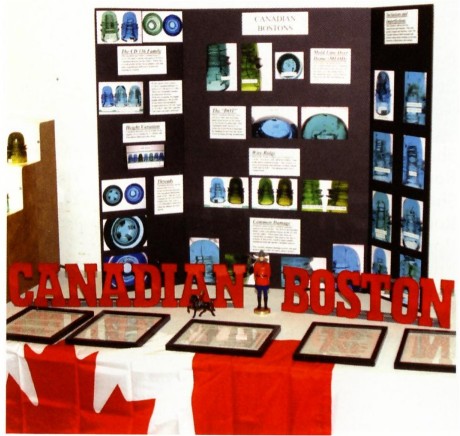 |
Editor's note:
Jim's display of Canadian Bostons won the award for "most educational" exhibit at the 2006 Mid-Ohio show
in Springfield, Ohio last
November.
A portion of the exhibit is shown at the left.
|
|
